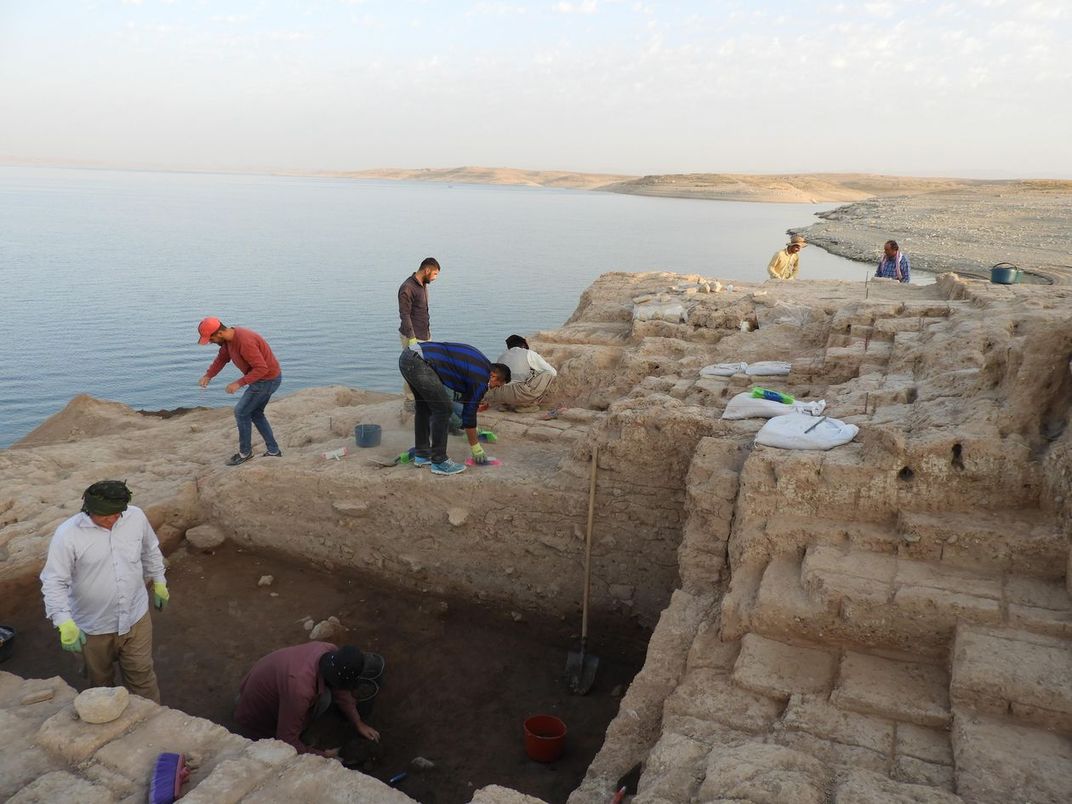Drought Reveals Ancient Palace in Iraqi Reservoir
A team of Iraqi and German archaeologists excavated the rare Mittani structure before it was swallowed by water once more
/https://tf-cmsv2-smithsonianmag-media.s3.amazonaws.com/filer/68/ad/68ad9e7a-fd42-4225-bf6d-344c85701e6e/iraq_palace.jpg)
Last fall, as a drought gripped northern Iraq, the water in the reservoir held back by Mosul Dam receded enough to reveal an ancient palace dating to the Mittani Empire.
A joint German and Iraqi squad of archaeologists led a rescue excavation of the site, known as Kemune, before the palace was once again swallowed by the waters of the reservoir.
Despite the short field season, they were able to learn much about the palace, partially excavating eight of 10 rooms found within the complex. They discovered fired bricks used as floor slabs and 10 cuneiform tablets, which are currently being translated. One of them indicates that Kemune may be the ancient city of Zakhiku mentioned in other documents, suggesting the city must have lasted at least 400 years.
During the 13th and 14th centuries B.C., the palace would have overlooked the eastern bank of the Tigris River, with a monumental terrace of mud bricks shoring up the structure. The palace itself is made of massive mud-brick walls, some six feet thick. A standout of the excavation was finding remains of wall paintings in vibrant shades of red and blue. “In the second millennium BCE, murals were probably a typical feature of palaces in the Ancient Near East, but we rarely find them preserved,” Puljiz says in a press release. “So discovering wall paintings in Kemune is an archaeological sensation.”

The palace was actually first spotted in 2010 when parts of it emerged from the reservoir. But it wasn’t until last fall that enough of the structure emerged that it could be excavated. Puljiz tells Jack Guy at CNN that shortly after the dig concluded the palace disappeared once more under the lake. “It is unclear when it will emerge again,” she says.
The team is hoping that the artifacts collected from the dig are enough to shed some light on the Mittani. “From the texts we hope to gain information on the inner structure of the Mittani Empire, its economic organization, and the relationship of the Mittani capital with the administrative centers in the neighboring regions," Puljiz tells Guy.
Most of what we know about the empire comes from a handful of sites including Tell Brak in Syria and two sites called Nuzi and Alalakh at the edges of the empire. Getting information from the heart of the civilization could unlock previously unknown revelations.
At one point, the Mittani Empire stretched from the eastern Mediterranean in modern-day Turkey and Syria to the eastern region of northern Iraq. The empire was one of the great powers of the Near East, but most of what we know about it comes from correspondence between the kings of the Mittani with Egypt and Assyria. In a bit of trivia, the world’s oldest horse-training manual also comes from the Mittani; its people were known for their horsemanship and developed lighter, faster spoked wheels for their war chariots.
Ultimately, Mittani was attacked by the Hittites and, later, the Assyrians, who turned the region into a vassal state; from a great power, the kingdom’s absorption into Assyria would put Mittani on its path to becoming the “forgotten empire" of the Near East.